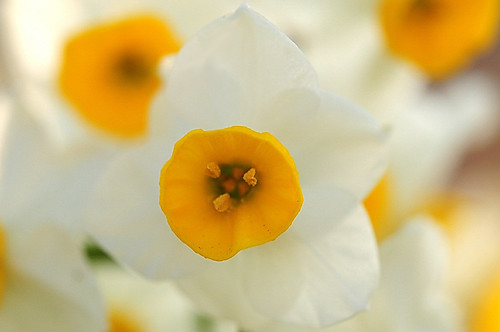Studying Narcissus
Studying narcissus absolute leads to interesting conclusions... The absolute is very different from the fresh flower, which grows wild from bulbs in the Mediterranean region. Wild narcissus blooms in the coldest days of the winter, so living in the Northern Hemisphere, where daffodils and narcissus are associated with spring took a while to get used to for me...
Growing up in the little village in northern Israel, there was nothing more delightful than spotting narcissus flowers while puddle hopping. We would just follow our noses and find them hiding among thorny bushes with their delicate yolk centre and crisp white petals. But the closer you get - the stinkier, more indolic, animalic and revolting the scent is... Kind of like a narcissistic person - which is charismatic and attractive until you get to know them better and realize how much they stink!
The closest thing I smelled in terms of raw materials to living narcissus was a sample of para-cresyl acetate that my friend Laurie Erickson sent me a while back. The absolute, however, smells nothing like it at all, and brings very surprising notes and complexity that makes it a very intriguing raw material, which I would have happily used more often if it wasn't for its extremely prohibitive cost. It also makes me steer clear of the cliches for narcissus (i.e.: the young mythical lad staring at himself in the pond until drowning in his own superficial beauty...), and look at it in a new angle, that is more sensory and less cerebral.
Opening with surprisingly green, herbaceous notes, narcissus absolute (from Narcissus Poeticus) possesses creamy floralcy reminiscent of tuberose absolute, but layered with far more greenery reminiscent of mint, hay and tomato leaf absolute. There's something dirty and slightly repulsive about it - almost like a heap of rotting garden weeds. The dryout is reminiscent of hay, and is a tad powdery. Still bears a strong resemblance to tomato leaf absolute but softer.
In Arctander's words (p. 433): "The odor of narcissus absolute is strongly foliage-green, very sweet-herbaceous over a fainr, but quite persistent floral undertone". Arctander also distinguishes between two varieties of narcissus absolutes that are produced - "des plaines" from the Grasse area, which is "orange-colored, very viscous, and has a floral-sweet, mild and rich, but not very powerful odor"; and the "des montagnes" variety, which comes mainly from Esterel in Southern France and is "greenish-brown, viscous liquid of green and somewhat earthy type. The undertone is sweet and balsamic-spicy, reminiscent of carnation and hyacinth, but still carrying a strong, green-foliage note". It's hard for me to tell which specimen is the sample that I'm holding, as usually the location relates only to country, not exact region or city (and in this case - both varieties are from the south of France). If to guess by the appearance alone of the oil, it could very likely be the "des plaines" as it has an orange colour; but to judge by the smell - it fits the description of the "des montagnes", and is very tenacious.
Another type of narcissus is jonquil absolute - a cultivated variety (Narcissus Jonquilla) which is more rare and even more expensive than narcissus, and its scent is sweeter and more floral (tuberose-like) and honeyed with hay and green undertones very similar to that of the narcissus absolute, or as Arctander describes it "... heavy, honeylike, deep-sweet floral odor with a strong green undertone and a somewhat bitter, very tenacious dryout note. The odor bears great similarity to the fragrance of longoza and tuberose, and a remote resemblance to hyacinth".
I feel I will need to spend more time with this both of these absolutes to fully grasp their depth and complexities. They are by no means pretty or easy to work with. But that's exactly what I find intriguing and fascinating about them. And I've been deriving immense pleasure blending with them and bringing forward their animalic and floral characteristics while embracing their foliage and earthy aspects. Essences with such complexity and dichotomy unleash my imagination and take me to unexpected places.

